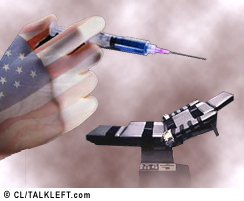How the drugs are administered:
The major criticism of the three-drug execution procedure is that if the executioner administers too little anesthetic or makes mistakes in injecting it, the inmate could suffer excruciating pain from the other two drugs.
Heath testified that the design of Ohio's death house was problematic because it separates the inmate from the person administering the drugs in two separate rooms. The rooms are separated by a one-way mirror. "Doing it that way substantially increases the risk of a major problem occurring," said Heath, adding later, "I would never induce general anesthesia from a different room through long tubing."
Anesthesiologists always administer drugs while standing next to the patient so they can detect if problems occur, such as a leak or a ruptured vein, Heath said. He also warned drugs could go into the tissue instead of the vein.
Then there's the chemicals themselves:
Heath said potassium chloride, the third drug administered, which stops the heart, is sometimes used for euthanizing animals. He added that in veterinary procedures the person administering the drug has to be trained in assessing the depth in which the animal is sedated and would have to be present at the bedside. "That's a major violation or departure from any acceptable veterinary standard," Heath said of Ohio's method.
Other problems that could occur come during the mixing of the anesthetic - sodium thiopental, which is sold in powder form - and the insertion of the catheters in the veins and kinks in the IV tubing, he said.
Back to the new study, here's the abstract:
This article studies state laws governing animal euthanasia and concludes that many more states than have previously been recognized ban the use of paralyzing agents in animal euthanasia. In fact, 97.6% of lethal injection executions in this country have taken place in states that have banned, for use in animal euthanasia, the same drugs that are used in those states during executions. Moreover, a study of the legislative history of state euthanasia laws reveals that the concerns raised about paralyzing drugs in the animal euthanasia context are identical in many ways to the concerns that lawyers for death row inmates are currently raising about the use of those drugs in the lethal injection executions of human beings.
This article takes an in depth look at animal euthanasia and its relationship to lethal injection by examining in Part I the history and origins of the paralyzing drugs that veterinarians and animal welfare experts refuse to allow in animal euthanasia; in Part II the standards of professional conduct for veterinary and animal shelter professionals; in Part III, the state laws and regulations governing animal euthanasia; and finally in Part IV, the legislative history that led to the enactment of the various states' animal euthanasia laws and regulations.
Also check out the report by Human Rights Watch, So Long as They Die.
The Supreme Court will decide the issue of whether the three drug cocktail violates the 8th Amendment ban on cruel and unusual punishment this term in Baze v. Rees.
Regardless of the outcome, this article in the New England Journal of Medicine explains why physicians should not participate in executions.
Physicians and other health care providers should not be involved in capital punishment, even in an advisory capacity. A profession dedicated to healing the sick has no place in the process of execution.
On January 7 in oral arguments in Baze v. Rees, the justices asked many important and thoughtful questions about a potential role for physicians and other health care professionals in executions. In their fuller examination of Baze v. Rees, the justices should not presume that the medical profession will be available to assist in the taking of human lives.
We believe that, like the anesthesiologists in the Morales case, all responsible members of the medical profession, when asked to assist in a state-ordered execution, will remember the Hippocratic Oath and refuse to participate. The future of capital punishment in the United States will be up to the justices, but the involvement of physicians in executions will be up to the medical profession.




